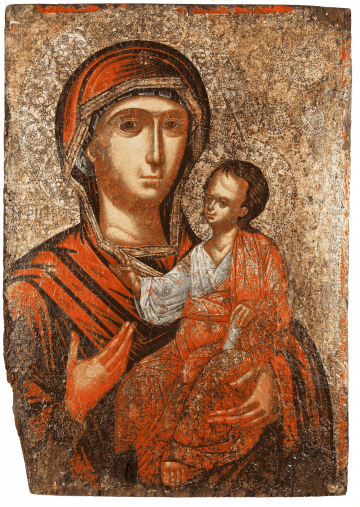The Mother of God “Hodegetria” – the One who Shows the Way
(Greece; sixteenth century)
Greece; sixteenth century; 76.8 x 54.5 cm
Feast: July 28
History of the icon:
Hodegetria – the Leader, holds a privileged place among the icons that depict the Mother of God. According to the testimony of Byzantine historians, the Empress Eudoxia, the wife of Emperor Theodosius II (408-450), sent the icon to Constantinople from Jerusalem to her mother-in-law Pulkheria. Tradition also states that the icon was written by the holy evangelist Luke and was blessed by the Mother of God herself with the words: “My grace will be on this icon.”
Interestingly, the existence of Hodegetria in Constantinople was confirmed much later and the chroniclers primarily speak of the renowned monastery and shrine of Hodegetria, which was built by Emperor Michael III (842-867). It was called the “Temple of Leaders” (Greek Μονὴ τῶν Ὁδηγῶν), because troop commanders would go there before leaving for the battlefield to pray in front of the icon that bore the name of the shrine: Hodigos, later Hodegetria.
The legend explains the name as being connected with a miracle that the Mother of God preformed. The Mother of God appeared in Constantinople to two blind people, took their hands and brought them to the sanctuary of Hodegetria, where she restored their sight. Since this time, the blind and those suffering from eye diseases have gone to the spring, that sprung up in front of the temple, and washed their eyes to be healed. It was this legend that made Hodegetria’s image a source of grace for those who were seeking God. In addition, it makes it apparent that Mary is the one who shows the way to God – Hodegetria (Greek: Ὁδηγήτρια, literally: “She who shows the Way”).
Description of the icon:
The first of the basic components that distinguishes Hodegetria from other depictions of the Mother of God is the rotation of the faces of both figures. They are not looking at one other, but their eyes are directed at the viewer, whom Christ blesses with his right hand. The blessing fingers form the symbolism of the letters IC XC, i.e. “In the name of Jesus Christ.” These initials can also be seen in the circles above the aureole of Christ. The faintly visible letters Ѡ (omega), Ѻ (omicron) and N (nu), in his aureole refer to the Old Testament, where God answered Moses’ question as to who sent him to Pharaoh: “I am who I am” (Exodus 3:14). It is a confirmation that God, the creator of the world, was not visible in the Old Testament. He was only present through His voice, being the same God who incarnated. This is also confirmed by Christ’s scroll in his left hand “And the Word became flesh and dwelt among us” (John 1:14). The Mother of God’s hand points to Christ, who said of himself: “I am the way, the truth, and the life. No one comes to the Father except through Me” (John 14:6).
The extraordinarily subtle features of the Mother of God, the small head of the child, the extended proportions and the ingenious treatment of the expressions testify to the high professionalism of the artist. The plant motifs in the aureoles of both figures on the icon are also beautiful details, this being a typical element in the decoration of icons since the sixteenth century. These can be seen not only in the areoles, but also in the clothes or the background of the icons.
The main intention of the iconographer was to obviously highlight the grandeur and dignity of the entire scene. The distinctive red robe of the Mother of God indicates that through her Son she became the queen of heaven. Her human nature is expressed by the blue scarf that covers her hair and which is barely visible from under the golden edges of the maphoria (μαφόριον, the robe covering her head and shoulders). The three stars, on her shoulders and forehead, symbolize her inviolable virginity before, during and after the birth of Christ. The left star is replaced by Christ with his body. The letters “ΜΡ ΘΥ” (Μήτηρ θεoύ) – Mother of God are above the head. Only the second syllable – “ΘΥ” - is partially visible on the icon, however, which is due to the fact that the left part of the icon has been cut off.


